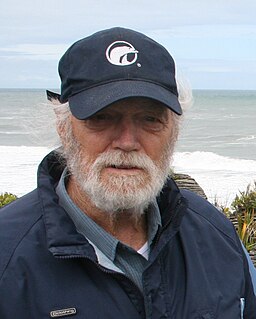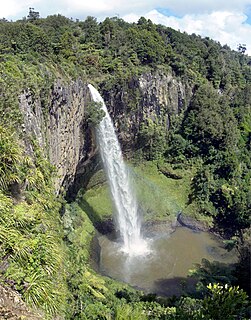Related Research Articles

Hydrology is the scientific study of the movement, distribution, and management of water on Earth and other planets, including the water cycle, water resources, and environmental watershed sustainability. A practitioner of hydrology is called a hydrologist. Hydrologists are scientists studying earth or environmental science, civil or environmental engineering, and physical geography. Using various analytical methods and scientific techniques, they collect and analyze data to help solve water related problems such as environmental preservation, natural disasters, and water management.

A geographer is a physical scientist, social scientist or humanist whose area of study is geography, the study of Earth's natural environment and human society, including how society and nature interacts. The Greek prefix "geo" means "earth" and the Greek suffix, "graphy," meaning "description," so a geographer is someone who studies the earth. The word "geography" is a Middle French word that is believed to have been first used in 1540.

Hydrography is the branch of applied sciences which deals with the measurement and description of the physical features of oceans, seas, coastal areas, lakes and rivers, as well as with the prediction of their change over time, for the primary purpose of safety of navigation and in support of all other marine activities, including economic development, security and defense, scientific research, and environmental protection.
The Commonwealth Secretariat is the main intergovernmental agency and central institution of the Commonwealth of Nations. It is responsible for facilitating co-operation between members; organising meetings, including the Commonwealth Heads of Government Meetings (CHOGM); assisting and advising on policy development; and providing assistance to countries in implementing the decisions and policies of the Commonwealth.

The National Trust of Australia, officially the Australian Council of National Trusts (ACNT), is the Australian national peak body for community-based, non-government non-profit organisations committed to promoting and conserving Australia's indigenous, natural and historic heritage.
The Biological Records Centre (BRC) established in 1964, is a national focus in the UK for terrestrial and fresh water species recording.

The European Geosciences Union (EGU) is a non-profit international union in the fields of Earth, planetary, and space sciences whose vision is to "realise a sustainable and just future for humanity and for the planet." The organisation has headquarters in Munich (Germany). Membership is open to individuals who are professionally engaged in or associated with these fields and related studies, including students and retired seniors.

The Royal Society Te Apārangi is an independent, statutory not-for-profit body in New Zealand providing funding and policy advice in the fields of sciences and the humanities.

David McNiven Garner was notable as a published research physicist, with a focus in physical oceanography and ocean circulation.
Arthur Nelson Field was a New Zealand journalist, writer and political activist.

Kurī is the Māori name for the extinct Polynesian dog. It was introduced to New Zealand by the Polynesian ancestors of the Māori during their migration from East Polynesia in the 13th century AD. According to Māori tradition, the demigod Māui transformed his brother-in-law Irawaru into the first dog.
The Ornithological Society of New Zealand (OSNZ), also known as Birds New Zealand, is a non-profit organisation dedicated to the study of birds and their habitats in the New Zealand region. Founded in 1940, it caters to a wide variety of people interested in the birds of the region, from professional ornithologists to casual birdwatchers.
The rivers of New Zealand are used for a variety of purposes and face a number of environmental issues. Many of the rivers in the South Island are braided rivers.
An ariki, ꞌariki, aliki, ali‘i, ari'i, aiki or hakaiki, akariki or ‘eiki (Tonga) is or was a member of a hereditary chiefly or noble rank in Polynesia.
The International Association of Hydrological Sciences (IAHS) is a non-profit non-governmental scientific organisation committed to serving the science of hydrology and the worldwide community of hydrologists. The IAHS was established in 1922, and presently claims a membership in excess of 9,000 with members in over 150 countries.

The Kopuatai Peat Dome is a large peatland complex on the Hauraki Plains in the North Island of New Zealand. It consists of two raised domes, one in the north and the other in the south, that are up to three metres higher at the center than at the edge. The 10,201 hectares wetland contains the largest intact raised bog in New Zealand and was listed under the Ramsar Convention in 1989 as a Wetland of International Importance. Most of the wetland is ombrotrophic, meaning it receives water and nutrient inputs solely from rain and is hydrologically isolated from the surrounding canals and rivers. Locally, a popular misconception persists that water flows from the nearby Piako River into the bog and that the wetland acts as a significant store for floodwater.

Water is relatively abundant in New Zealand due to the temperate climate and maritime weather patterns. In recent years, water pollution and draw-down of aquifers have become important environmental issues in New Zealand.

Camakau are a traditional watercraft of Fiji. Part of the broader Austronesian tradition, they are similar to catamarans, outrigger canoes, or smaller versions of the drua, but are larger than a takia. These vessels were built primarily for the purposes of travelling between islands and for trade. These canoes are single hulled, with an outrigger and a cama, a float, with both ends of the hull being symmetrical. They were very large, capable of travelling open ocean, and have been recorded as being up to 70 ft in length.
The New Zealand Mathematical Society is a New Zealand based learned society of mathematicians. It is listed by the Royal Society of New Zealand as the affiliate organisation responsible for mathematics research, and by the International Mathematical Union as the national mathematical society of its country. The total membership in the society has varied from approximately 100 soon after its 1974 foundation to between 200 and 300 at its 25th anniversary in 1999.
The New Zealand Institute of Chemistry (NZIC) was founded in 1931 and is the professional membership organisation for professionals working in the field of chemistry across the education and industry sectors in New Zealand. It is organised into six geographical branches and a number of specialist groups.
References
- ↑ "Our Constituent Organisations".
- ↑ "Journal of Hydrology (New Zealand) on JSTOR". JSTOR . Retrieved 11 December 2018.